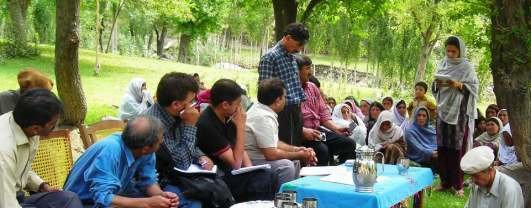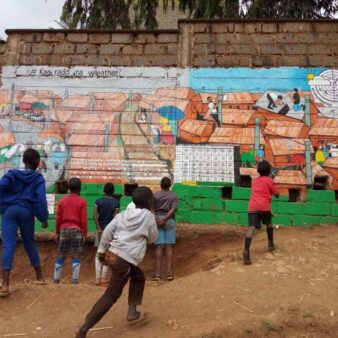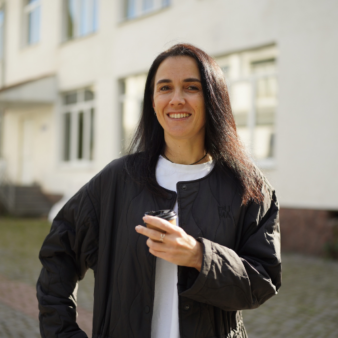The Building and Construction Improvement Programme works with local communities in Pakistan to develop and manufacture a range of affordable, environmentally- and regionally-appropriate home improvement products. Over 60 different products have been tested and applied to date, benefiting nearly 70,000 people across 125 villages in the Northern Areas and Chitral.
Project Description
Aims and Objectives
The underlying vision of the Building and Construction Improvement Programme (BACIP) is centred on the Aga Khan’s philosophy that “a proper home can provide the bridge across that terrible gulf between poverty and a better future.” Improved indoor living conditions directly impact on health (physical and mental) and economic conditions of individuals, as well as the environment in which they live. BACIP works not only to advance housing standards but also to provide a means to improve socio-economic conditions whilst minimising the burden on natural resources.
The main groups benefiting from the programme are low-income rural families living in the Northern Areas and Chitral regions of Pakistan.
BACIP works with local communities in Pakistan to develop, manufacture and deliver a range of affordable, environmentally- and regionally-appropriate home improvement products, which provide practical and imaginative solutions to inadequate living conditions. BACIP products and technologies developed in partnership with local communities range from small-scale items like double-glazed windows and composting toilets to building methodologies such as earthquake-resistant, energy efficient housing construction and insulation techniques. BACIP products and technologies also include lightweight insulated roofs, thermally-efficient housing construction techniques, fuel-efficient stoves, solar products, bow string and composite beams for reduced timber use for roof construction, a water warming facility, earthquake-resistant wire wall reinforcement as a direct replacement for timber wall reinforcement and roof-hatch windows, amongst others.
BACIP works with community members to identify housing needs and then determine appropriate products to meet these requirements. As part of this strategy, BACIP identifies women from local communities who can obtain information from other local women about housing and product needs, and then arrange for product delivery. BACIP has developed, tested and applied over 60 different products to improve living conditions in the Northern Areas and Chitral.
Since the start of the programme in 1997, over 17,237 BACIP products have been installed in 8,619 households in the programme area, benefiting over 68,948 people across 125 villages. Training has also been provided to over 85 entrepreneurs and 353 crafts persons in the design, production and installation of BACIP products, creating sustainable livelihoods in a number of target communities.
Funding for the programme has been provided by the Canadian International Development Agency (CIDA), USAID, the UNDP GEF Small Grants Programme and the Pakistan Poverty Alleviation Fund. Total BACIP investment from all donors over the last eight years has amounted to approximately US$1.5 million.
BACIP was created as a result of in-depth community studies by Aga Khan Planning and Building Service, Pakistan (AKPBSP) and partner organisations which sought to identify the needs and aspirations of populations in the target areas. In each village that BACIP partners with, organisers hold a series of workshops to understand the issues facing individual villages. Community members then give input into the research, design and refinement of each BACIP product to ensure regional sensibility, efficiency and applicability. In each village, the community is involved at four major stages:
- Participatory research and development phase
- Promotion of end products
- Manufacturing and installation
- Monitoring and evaluation
The most powerful indicator of social and cultural sustainability of the programme interventions has been the improvement of the quality of life, especially of the youth (both male and female), achieved through the provision of employment generation opportunities and income-increasing entrepreneurial capacity. BACIP improvements to indoor living conditions have had the greatest impact on the lives of women, who spend the greatest amount of time inside the home. Their burden of work is reduced through ease in collecting water and firewood, cleaning and cooking, as well as other chores.
BACIP focuses on the development and implementation of individual products for home improvement rather than on issues relating to housing policy. However, its participatory research and implementation process has received support at local government level and has been adopted by a number of district villages in Sindh, in the south of Pakistan.
Why is it innovative?
BACIP is one of the first initiatives to address the indoor built environment through an integrated approach that emphasizes social, economic and environmental sustainability. The participatory research, extension, review and documentation process ensures that the products meet community needs and are easily replicable. Direct community involvement at all stages of the process allows BACIP the flexibility to address different regions and socio-economic conditions.
Local production keeps costs low and allows for independent local ownership of the programme. BACIP is one of the few programmes in the region to operate on a ‘no-subsidy’ basis. Through a partnership with the First Micro Finance Bank, micro-credit is provided to homeowners for the purchase of BACIP products, increasing accessibility in the target communities.
What is the environmental impact?
The programme has had positive environmental impacts in the wider sphere, with decreased household greenhouse gas emissions resulting from the decreased use of timber and fossil fuels.Building materials used and developed by BACIP are locally produced and sourced.
Internal and external impact assessments have shown that BACIP stoves, windows, water warming, insulation and construction technologies have reduced annual household biomass consumption by up to 60 per cent. BACIP smoke-free stoves and insulation techniques have decreased household greenhouse gas emissions by over 50 per cent and reduced in-house smoke and other air pollutants by over 80 per cent.
Is it financially sustainable?
BACIP operates on a ‘no subsidy’ basis, meaning that households must pay for the cost of the end product. However, this cost is based solely on materials and manufacturing, as the research and development is fully funded by AKPBSP with financial support from its donors and the Aga Khan Foundation. For most products, the associated savings in expenditure quickly pay for the initial product costs.
Micro-credit loans have been arranged with local financial institutions to assist in the creation of sustainable livelihoods in the region. To date, 22 small entrepreneurial establishments have been set up and over 200 entrepreneurs, artisans and others have been trained by BACIP in the design, manufacturing and installation of BACIP products and are currently working as skilled labourers or self-employed contractors. The programme has increased the income of community entrepreneurs and multi-trade craftsmen by 25 per cent through its training and skills enhancement programmes.
The implementation of BACIP products has led to annual household savings of 50 per cent in fuel wood expenditures and a 25 per cent saving in health-related household expenditure.
What is the social impact?
The programme has worked to engage local communities and in particular youth, women, the elderly and other marginalised groups in the planning and design of programme interventions such as social outreach, advocacy, social support and the establishment of a vibrant community.
BACIP carries out a range of training and skills enhancement programmes. The products developed by the programme are manufactured and sold by local entrepreneurs and artisans who are trained by AKPBSP-BACIP in the respective trades as well as in entrepreneurial skills.
There has been a 50 per cent decrease in reported cold- and smoke-related illnesses amongst households that have implemented BACIP products. Children, in addition to being healthier, are better able to read and do homework inside the house due to improved lighting and indoor air quality.
The creation of sustainable livelihoods and the engagement of marginalised groups has contributed toward the reduction of social inequalities in participating communities. Encouraging women to partner in research, design and decision-making processes has given them a greater voice in their homes and in the community.
Barriers
One of the greatest obstacles faced was the issue of not providing subsidy to the local population for the purchase of fuel-efficient products. The communities are used to receiving subsidies from other NGOs. Although this approach did hinder the pace of transfer, slower transfer under a non-subsidy approach was deemed to be more sustainable.
Some formal sector engineers, architects and contractors are hesitant about using alternative BACIP technologies, lacking the understanding and/or the technical expertise to integrate these into their working systems. BACIP is currently exploring ways to provide information to mainstream professionals in the public and private sectors on the benefits of its products.
Social and cultural traditions can lead to the non-acceptance of certain products and materials, such as the resistance to roof hatch windows in Nathia Galli, which can pose obstacles in the promotion and transfer of BACIP products. The participatory product development process, product demonstrations and the provision of micro-finance schemes have increased the adoption rate of BACIP home improvement technologies and products.
Various studies have indicated the presence of a large market for BACIP products and have quoted constraints in supply and information channels rather than demand. BACIP is looking to increase supply and information but does not wish to compromise on quality. The issue of quality control is crucial for the purposes of future transfer and sustainability.
Lessons Learned
The BACIP programme methodology and products have undergone a number of refinements, making the programme innovative and yet flexible to rapidly changing scenarios. Multiple channels of feedback from the community, users, non-adopters, networks of village organisations and BACIP internal monitoring enable a continuous cycle of improvement and generation of ideas. A more product-focused approach is slowly giving way to an approach that responds to customer and market demands.
The programme itself demonstrates an effective transition from a research and development project to applied action research, extension and service delivery. More is planned along these lines and increasing efforts are being made to develop cross-sectoral, cross-functional partnership linkages with other organisations in the development sector.
Successful dissemination and achieving a high adoption rate is labour and time intensive and should be coupled with strong demonstration effects, intensive and regular follow-ups and constant motivation and awareness-raising activities.
Evaluation
The community is integral in providing feedback on the project both formally and informally. Information provided by those that use the products, as well as those who choose not to, plays an important role in evaluating, monitoring and improving the BACIP products. Further feedback comes from community organisations and BACIP entrepreneurs as part of their responsibility to the programme.
Performance and impact indicators for programme implementation along with their corresponding means of verification were established at programme inception and a rigorous internal monitoring and evaluation process has been carried out. Various reports and publications have been produced. The programme was also submitted to two independent external evaluations in the form of a Mid-Term Evaluation and a Final Evaluation.
The Programme has seen:
- Improved built environment and living conditions.
- Increased use of improved household products and technologies.
- Improved health and socio-economic conditions.
- Decreased household emissions of greenhouse gases.
- Expertise of young people in managing their own financial and social affairs.
- Engagement in productive efforts to increase the welfare of the community as a whole.
- Take-up and transfer of the approach.
Transfer
UNDP funding was obtained to undertake similar projects in the south of Pakistan, with different cultural and climatic conditions. The participatory process has allowed for easy adaptation and transfer of the approach. Recent funding from UNDP and the Pakistan Poverty Alleviation Fund will allow BACIP to expand into another 15 villages in the Northern Areas and Chitral regions. The Alcan Prize for Sustainability of US$1 million was received by AKPBSP in 2005. It will be used to strengthen the BACIP programme and to apply the elements of the approach in the reconstruction of communities devastated by the earthquake that struck Northern Pakistan in October 2005.
Since 1997 AKPBSP has installed 700 demonstration models of its 60 products in various villages in the Northern Areas of the country. By 2005, over 12,500 AKPBSP products had been replicated by community members at their own expense. Similar projects have been undertaken in the Sindh, Azad Jammu-Kashmir and Nathiagali regions of the country.
Internationally, AKPBSP has engaged in a number of knowledge-sharing measures to disseminate the techniques and lessons learnt from BACIP. The work of the organization with a number of civil society institutions, NGOs and CBOs has led to the transfer and application of many elements of the approach.
Partnership
Donor Agency, Local Community



